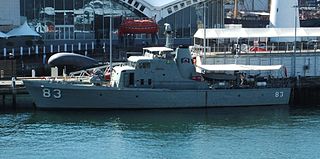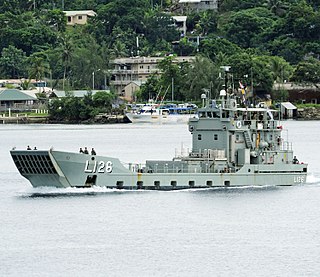
The Papua New Guinea Defence Force (PNGDF) is the military organisation responsible for the defence of Papua New Guinea. It originated from the Australian Army land forces of the territory of Papua New Guinea before independence, coming into being in January 1973 and having its antecedents in the Pacific Islands Regiment. The PNGDF is a small force, numbering around 3,600 personnel, and consists of a Land Element, an Air Element and a Maritime Element. It is a joint force tasked with defending Papua New Guinea and its territories against external attack, as well as having secondary functions including national-building and internal security tasks.

HMAS Aitape was an Attack-class patrol boat of the Royal Australian Navy (RAN). It was named for the small town of Aitape, Sandaun Province, Papua New Guinea. Completed in 1967, the vessel was one of five assigned to the RAN's Papua New Guinea (PNG) Division. The patrol boat was transferred to the Papua New Guinea Defence Force in 1974 as HMPNGS Aitape. She remained active until 1982, when she was removed from service for use as a parts hulk. Aitape was scuttled off Port Moresby for use as a dive wreck in 1995.

HMPNGS Lakekamu is Balikpapan-class landing craft heavy (LCH) operated by the Maritime Operations Element of the Papua New Guinea Defence Force (PNGDF). The vessel was one of eight built for the Royal Australian Navy (RAN) in the 1970s, and was commissioned into the RAN as HMAS Labuan in March 1973. Labuan was decommissioned in November 2014. She was transferred to the PNGDF for use as a training ship and was commissioned as HMPNGS Lakekamu in December 2014.

HMAS Ladava was an Attack-class patrol boat of the Royal Australian Navy (RAN). It was named after the small village of Ladava situated on the shore of Milne Bay in Alotau District, Papua New Guinea. Completed in 1968, the vessel was one of five assigned to the RAN's Papua New Guinea (PNG) Division. The patrol boat was transferred to the Papua New Guinea Defence Force in 1974 as HMPNGS Ladava. The patrol boat was decommissioned in 1988, although her fate is unknown.

HMAS Madang, named for the settlement of Madang in New Guinea, was an Attack-class patrol boat of the Royal Australian Navy (RAN). Completed in 1968, the vessel was one of five assigned to the RAN's Papua New Guinea (PNG) Division. The patrol boat was transferred to the Papua New Guinea Defence Force in 1974 as HMPNGS Madang. She was decommissioned in 1989.

HMAS Samarai, named after the island of Samarai and its former town, was an Attack-class patrol boat of the Royal Australian Navy (RAN). Completed in 1968, the vessel was one of five assigned to the RAN's Papua New Guinea (PNG) Division. The patrol boat was transferred to the Papua New Guinea Defence Force in 1974 as HMPNGS Samarai. She remained in service until 1987, when she was paid off and used as a parts hulk.

HMAS Lae was an Attack-class patrol boat of the Royal Australian Navy (RAN). It was named for the city of Lae, capital of Morobe Province, Papua New Guinea. Completed in 1968, the vessel was one of five assigned to the RAN's Papua New Guinea (PNG) Division. The patrol boat was transferred to the Papua New Guinea Defence Force in 1974 as HMPNGS Lae. She remained in service until 1988.

Milne Bay is a large bay in Milne Bay Province, south-eastern Papua New Guinea. More than 35 kilometres long and over 15 kilometres wide, Milne Bay is a sheltered deep-water harbor accessible via Ward Hunt Strait. It is surrounded by the heavily wooded Stirling Range to the north and south, and on the northern shore, a narrow coastal strip, soggy with sago and mangrove swamps. The bay is named after Sir Alexander Milne.

The Balikpapan class is a ship class of eight heavy landing craft. All eight were originally laid down by Walkers Limited for the Australian Army in the early 1970s. A reorganisation of watercraft responsibilities in the Australian military meant the landing craft were to be operated by the Royal Australian Navy (RAN), with seven commissioned directly into RAN service during 1973 and 1974, and lead ship Balikpapan transferred from the army to the navy. During the leadup to the independence of Papua New Guinea in 1975, two of the vessels were transferred to the new Papua New Guinea Defence Force (PNGDF).

The Pacific class is a class of 22 patrol boats built by Australia and donated to twelve South Pacific countries. They were constructed between 1985 and 1997 and are operated by militaries, coast guards or police forces of twelve island nations. These boats are supported by the Pacific Patrol Boat Program and used primarily for maritime surveillance and fisheries protection.
Lombrum Naval Base, also known as HMPNGS Tarangau and formerly PNG Defence Force Base Lombrum, is a naval military base operated by the Maritime Operations Element of the Papua New Guinea Defence Force (PNGDF). It is located on Manus Island in Papua New Guinea. Lombrum is the home port of the PNGDF's Pacific-class patrol boat force.
Edward Ramu (Ted) Diro GCL CBE is a Papua New Guinean politician and soldier.

The Guardian-class patrol boats are a class of small patrol vessels designed and built in Australia and provided to small South Pacific Ocean countries as part of the Australian Government's Pacific Maritime Security Program.

Operation Kurukuru is an annual joint exercise of Pacific Islands Forum nations, intended to combat illegal fishing. The first exercise took place in 2005.
The Forum Fisheries Agency is an organization run by the Pacific Islands Forum. It operates the Regional Fisheries Surveillance Centre, headquartered in the Solomon Islands, and annually runs an Operation Kurukuru—a joint effort to board and inspect suspicious fishing vessels.

HMPNGS Ted Diro (P401) is the first Guardian-class patrol boat to be completed. Australia designed and provided four Pacific Forum-class patrol vessels to Papua New Guinea in 1987 and 1988, and in 2015 confirmed she would be replacing those vessels with four larger, and more capable, Guardian-class vessels.

HMPNGS Rabaul (01) was the first Pacific Forum patrol vessel to be commissioned, in May 1987. She is not the first vessel of the class to go out of service, because her sister ship from Fiji RFNS Kiro was wrecked in 2016. She arrived in Port Moresby, for disposal, on October 24, 2018. The vessel was named HMPNGS Tarangau.

HMTSS Te Mataili II (802) is the second Guardian-class patrol boat completed, and the first to be given to the small Pacific Ocean nation Tuvalu. She was commissioned on 5 April 2019, replacing Te Mataili (801), a Pacific Forum patrol vessel, that had reached the end of her designed lifetime.
Rochus Lokinap was a military officer in Papua New Guinea. He held the rank of brigadier general in the Papua New Guinea Defence Forces (PNGDF) and was the PNG Defence Commander, in March 1990 when Police Commissioner Paul Tobian tried to execute a coup against government of Rabbie Namaliu. According to the Canberra Times Lokinap and Ted Diro, then Minister of State Security, rallied forces to thwart the coup.

Manus Naval Base was a number of bases built after the World War II Battle of Manus by United States Navy on the Manus Island and a smaller island just east, Los Negros Island in the Admiralty Islands chain. The major naval base construction started with the Los Negros landings on February 28, 1944. The Navy repaired and did the expansion of the airfields on the Admiralty Islands. United States Navy Seabee built or repaired the facilities on the islands. The large Manus Naval Base, also called the Admiralty Island base, supported United States Seventh Fleet, Southwest Pacific command, and part of the Pacific Fleet. The base was abandoned by the US Navy after the war.












